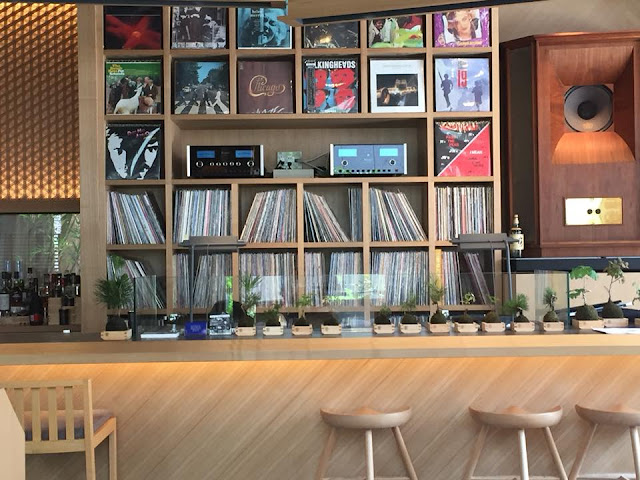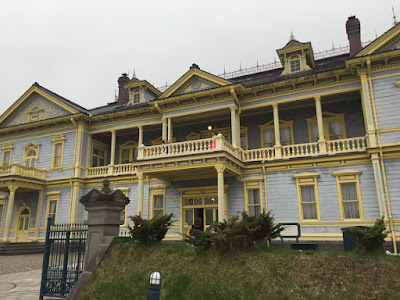Kanazawa
I chose Kanazawa as my last big trip in Japan. I had mostly been wanting to visit Kanazawa since I had arrived in Japan because an acquaintance from high school had lived in the same prefecture as Kanazawa for many years with his wife. However, once I started to learn more about what Kanazawa has to offer, I wanted to visit the city on its own merits (especially since my friend moved to the United States with his wife earlier this year).
Kanazawa is known as one of Japan's traditional cultural centers. Kanazawa is one of the few major cities (including Kyoto) in Japan that escaped bombing by US forces during World War II. As a result, there are many historic buildings that are still standing, which is most apparent in the Higashi Chaya-gai district. This area was traditionally the tea house and geisha district - a tradition that still continues as many of the businesses in the district seemed to be cafes that retained at least a little bit of the traditional decor of the original tea houses.
Aside from the historical buildings, Kanazawa is also famous for its artisan crafts. Merchants and artisans were granted special privileges for moving to Kanazawa to support the samurai population, thus starting a tradition of craftwork that has continued today. While I was there, I saw tons of porcelain. I also know that silk dying is another Kanazawan tradition that is still practiced there.
I arrived in Kanazawa around noon on a Saturday, and then I spent the rest of the afternoon walking around their nationally famous garden, Kenroku-en. It embodies the aesthetics of traditional Japanese gardens and it is considered one of the top 3 landscape gardens of Japan. It's hard to describe the garden, but my Lonely Planet guide informed me that the garden is named after a "Sung-dynasty garden in China that dictated six attributes for perfections: seclusion, spaciousness, artificiality, antiquity, abundant water, and broad views". All six of the attributes seemed to be well-represented here. While the garden did have a lot of tourists during the holiday weekend I was there, I didn't feel like it was crowded, so I was able to enjoy the garden in my own peaceful, private space. There is a beautiful traditional tea house within the garden, so I decided to pay to join the tea ceremony there. I believe it was an abbreviated form of the traditional tea ceremony, but we all kneeled as women in traditional clothing (kimonos?) served us green tea with a homemade, artistically designed treat. Afterwards, we were invited out back to admire their garden.
 After Kenroku-en, I went to the Kanazawa Castle grounds. Unfortunately, as a result of a fire in the late 1800s, the castle is slowly being reconstructed. It was closed for the day by the time I arrived, but I had heard that the inside was merely a museum. I have seen enough castles in Japan that I don't think I really needed to go inside. However, the grounds around the castle were beautiful, especially Gyokusen-Inmaru Garden which is a small traditional garden on one corner of the grounds.
After Kenroku-en, I went to the Kanazawa Castle grounds. Unfortunately, as a result of a fire in the late 1800s, the castle is slowly being reconstructed. It was closed for the day by the time I arrived, but I had heard that the inside was merely a museum. I have seen enough castles in Japan that I don't think I really needed to go inside. However, the grounds around the castle were beautiful, especially Gyokusen-Inmaru Garden which is a small traditional garden on one corner of the grounds.The next day, I went to Myoryuji, commonly known as Ninjadera (Ninja Temple). This is a temple that is not actually associated with ninjas in any way. However, this temple was built as a secret defensive military outpost. The temple has secret passages, hidden rooms, and traps throughout. From the outside, it looked like it had two floors. In fact, the temple has four floors with several layers. My inner child was beaming seeing all doors and floorboards magically open to hidden sets of stairs. After my tour of Myoryuji, I wondered around the Teramachi District some more. The Teramachi District has tons and tons of small temples littered throughout its sometimes labyrinthine neighborhoods.
After I left Teramachi, I made my way to Omachi Market. This market is dominated by fresh seafood vendors. As soon as I arrived, I found Mori Mori Sushi. Mori Mori is considered one of the best sushi restaurants in Kanazawa, and it's a conveyor belt sushi restaurant. I say this because generally the quality of sushi at conveyor belt sushi restaurants is not considered to be that high. However, as far I understood, the sushi they were using was bought fresh that morning (perhaps from the stalls within the same market?). I went to the restaurant at 11:00 a.m., and there was already an hour and a half long wait. Luckily, you can print out a ticket with a number. I was number 250 and if I remember correctly, they were at number 130. So, I walked around the market some more and bought a snack (octopus, meatballs, and mussels on skewers). I came back two hours later, and they were at 230, so I decided to just stick around. Once I finally got a seat, I spent about $50 on some of the best sushi I've ever had, and it was totally worth it.
On my way home, I went to the aforementioned Higashi-Chaya district to walk around. The area was really crowded in the late afternoon, so I didn't spend too long there. Part of me wishes that I had peaked into some of the tea houses, but if there weren't lines, there was a lot of foot traffic in and out of these shops, and like I said, I just didn't feel like dealing with the crowds at that time. However, the architecture seemed to be well intact from that period.
On my last day, I went to Nagamachi, which is the former district that housed samurai. The highlight of my ramble around Nagamachi was Nomura-ke. Nomura-ke was the former residence of the Normura - a family of high-ranking samurai. There was nothing extravagant about the residence except for perhaps the garden in the back (which, by today's standards, it not THAT extravagant at all). The residence was quaint and cozy with tatami floors and a wooden structure.

After Nagamachi, I went to the D.T. Suzuki museum. This museum is a very modern-designed museum dedicated to one of Japan's most prominent and influential Zen Buddhist thinkers: D.T. Suzuki, a Kanazawa native. Suzuki is often the one credited for bringing Zen Buddhism to the United States. As one can imagine, a museum dedicated to a pre-eminent Zen Buddhist thinker is not going to be designed like any old museum. There is a contemplation room that looks out on a shallow pool. Visitors are encouraged to sit in silence and stare out onto the pool in silent thought. There is also a learning space that has a small library of Suzuki's writing in English, Japanese, and Chinese (he was quadrilingual - Sanskrit being the fourth).
That was all the time I had before I had to catch my train. Overall, Kanazawa was a great place to visit. One of my favorite things to observe in East Asia is the juxtaposition and conflict between the traditional and modern, and I think that's truly represented in Kanazawa. There are chic, boutique shops next to (or sometimes within!) historical buildings. There are shops selling handmade porcelain and silk clothing while there are hipster second-hand stores and bars just a couple streets over. A great representation of where Japan has come from and where it's headed.






Comments
Post a Comment